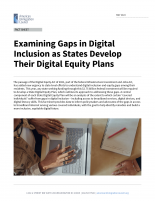- Fact Sheet
Examining Gaps in Digital Inclusion as States Develop Their Digital Equity Plans
Published
The passage of the Digital Equity Act of 2021, part of the federal Infrastructure Investment and Jobs Act, has added new urgency to state-level efforts to understand digital inclusion and equity gaps among their residents. This year, any state seeking funding through this $2.75 billion federal investment will be required to develop a State Digital Equity Plan, which outlines its approach to addressing these gaps. A central component of each State Digital Equity Plan will be an analysis of the extent to which certain “covered individuals” suffer from gaps in digital inclusion – including access to broadband services, digital devices, and digital literacy skills. This fact sheet, along with factsheets for key states, provides data to inform policymakers and advocates of the gaps in access to broadband internet among various covered individuals, with the goal to help identify remedies and build a more inclusive, equitable digital future.
The COVID-19 pandemic has vividly illustrated the economic and social costs of digital inequities—costs that have fallen disproportionately on people in marginalized communities, including immigrants, people of color, people with disabilities, and families living in poverty.
In these reports, we use data from the American Community Survey to examine the scale of the challenge and to see how many, and which, Americans could be helped by expanding broadband internet service.
More on examining digital inclusion across several key states:
- Examining Gaps in Digital Inclusion in California
- Examining Gaps in Digital Inclusion in Colorado
- Examining Gaps in Digital Inclusion in Florida
- Examining Gaps in Digital Inclusion in Illinois
- Examining Gaps in Digital Inclusion in Maryland
- Examining Gaps in Digital Inclusion in Massachusetts
- Examining Gaps in Digital Inclusion in Michigan
- Examining Gaps in Digital Inclusion in Minnesota
- Examining Gaps in Digital Inclusion in Nevada
- Examining Gaps in Digital Inclusion in New Jersey
- Examining Gaps in Digital Inclusion in New York
- Examining Gaps in Digital Inclusion in North Carolina
- Examining Gaps in Digital Inclusion in Ohio
- Examining Gaps in Digital Inclusion in Oregon
- Examining Gaps in Digital Inclusion in Texas
- Examining Gaps in Digital Inclusion in Utah
- Examining Gaps in Digital Inclusion in Virginia
- Examining Gaps in Digital Inclusion in Washington
- Examining Gaps in Digital Inclusion in Wisconsin
Help us fight for immigration justice!
The research is clear – immigrants are more likely to win their cases with a lawyer by their side. But very few can get attorneys.
Introducing the Immigration Justice Campaign Access Fund.
Your support sends attorneys, provides interpreters, and delivers justice.

Immigration Justice Campaign is an initiative of American Immigration Council and American Immigration Lawyers Association. The mission is to increase free legal services for immigrants navigating our complicated immigration system and leverage the voices and experiences of those most directly impacted by our country’s immigration policies to inform legal and advocacy strategies. We bring together a broad network of volunteers who provide legal assistance and advocate for due process for immigrants with a humane approach that includes universal legal representation and other community-based support for individuals during their immigration cases.

